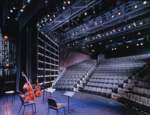Hostos Community College

Eugenio María de Hostos Community College of The City University of New York is a public community college in the South Bronx, New York City. It is part of the City University of New York (CUNY) system and was created by an act of the Board of Higher Education in 1968 in response to demands from the Hispanic/Puerto Rican community, which was urging for the establishment of a college to serve the people of the South Bronx. In 1970, the college admitted its first class of 623 students at the site of a former tire factory. Several years later, the college moved to a larger site nearby at 149th Street and Grand Concourse. The college also operates a location at the prow building of the Bronx Terminal Market.
Excerpt from the Wikipedia article Hostos Community College (License: CC BY-SA 3.0, Authors, Images).Hostos Community College
Grand Concourse, New York The Bronx
Geographical coordinates (GPS) Address Nearby Places Show on map
Geographical coordinates (GPS)
| Latitude | Longitude |
|---|---|
| N 40.8175 ° | E -73.927222222222 ° |
Address
Hostos Center for the Art and Culture
Grand Concourse
10451 New York, The Bronx
New York, United States
Open on Google Maps










